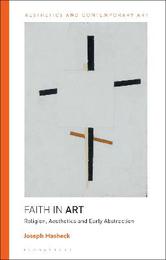
|
Faith in Art: Religion, Aesthetics, and Early Abstraction
Hardback
Main Details
Description
Metaphysical thought has been excluded from much of the discourse on modern art, especially abstract painting. By connecting ideas about faith with the initiators of abstract painting, Joseph Masheck reveals the extent spirituality has informed some of our most important abstract painters. Covering Wassily Kandinsky, Kazimir Malevich, Piet Mondrian and El Lissitzky, Masheck shows how theology has been an underlying but fundamental determinant of the thinking and practice of abstract painting from its originators down to the present. He contextualizes their art within some of the historical moments of the early 20th century, including the Russian revolution and the Stalinist period, and explores the appeal of certain themes, such as the Passion of Christ. A radical new theorization of the influence of spirituality over visual art, Faith in Art asks why metaphysics has been eliminated from the discussion where it might have something to say. This is a new way of thinking about a hundred years of abstract painting.
Author Biography
Joseph Masheck received the Distinguished Lifetime Achievement Award for Writing on Art, of the College Art Association, in 2018. He is Professor Emeritus of Art History at Hofstra University, Hempstead, New York, having also taught at Columbia and Harvard, USA.
ReviewsIn this rich and beautifully written book Masheck argues for the serious place of religion as opposed to the vague term spirituality in four founding artists of abstraction. Against the complex background of European culture the central place of Christian and Jewish theology and liturgy from icon to the writings of Karl Barth is affirmed and luminously presented. An intellectual and aesthetic feast. * The Revd Canon David Jasper, Emeritus Professor of Literature and Theology, University of Glasgow, UK * Masheck brilliantly corrects two blind spots regarding 'religion' in the history of modern art-first, by illuminating how Jewish and Christian conceptualities shaped the work of four pivotal modernists and, second, by exploring these as theological rather than (mis)attributing them to occultist spiritualities. The resulting account opens the history of modernism into lines of inquiry that art scholars have not yet adequately accounted for. * Jonathan A. Anderson, Postdoctoral Associate of Theology and the Visual Arts, Duke University, USA *
|